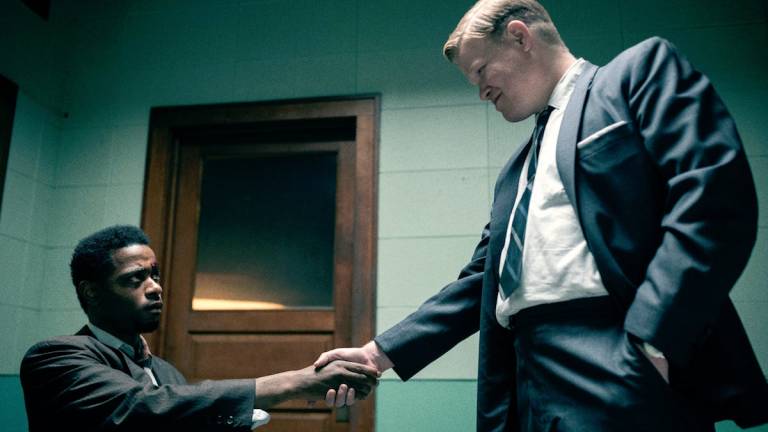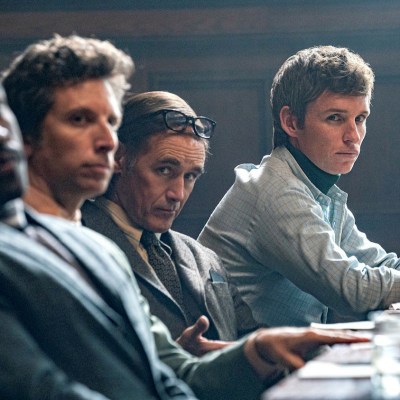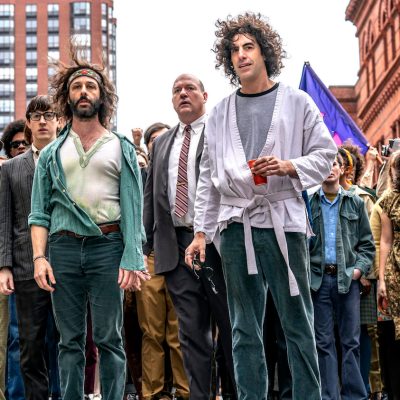Judas and the Black Messiah Ending Shows Horrific Legacy of COINTELPRO
The Judas and the Black Messiah ending, which recounts the death of Fred Hampton, underscores the tragic and often hidden legacy of the FBI’s COINTELPRO operations.

This article contains detailed Judas and the Black Messiah spoilers. Read our spoiler-free review here.
We don’t even see it happen. Like Deborah Johnson (Dominique Fishback) and the other seven Black Panther Party members fortunate enough to survive an all-out assault on a Chicago apartment, we only experience the sound of it. Off-screen and out of focus, police officers glibly taunt Fred Hampton (Daniel Kaluuya), who is still incapacitated in his bed despite all hell having just broken loose in his home. Then there’s that sickening noise: two shots are fired into Hampton’s head. We only bear witness to the anguish on Johnson’s face. She tells it plainly enough to us: Fred Hampton was just executed.
This is the heart-wrenching climax of Shaka King’s Judas and the Black Messiah, a striking piece of filmmaking that recounts how the chairman of the Illinois chapter of the Black Panther Party was shot to death in his bed after being betrayed by FBI informant William O’Neal (LaKeith Stanfield). It’s a sordid tale, made possible—and largely engineered—by the FBI’s illegal COINTELPRO operation, which infiltrated and illegally subverted any group they deemed radical.
Simply by existing, Judas and the Black Messiah is already doing so much. For the first time, Hollywood’s blinding hot spotlight is being pointed at the carnage wrecked by an extralegal effort which for years was denied, obscured, and outright lied about. For the first time, the mainstream is being asked to reckon with the full legacy of COINTELPRO.
Hiding an Atrocity in Plain Sight
“The Black Panther Party says there is a national conspiracy to wipe out their leadership and destroy their organization.” This is how the The New York Times began a story that scoffed at what turned out to be the actual facts of FBI Director J. Edgar Hoover’s covert and illegal war against the BPP. The article was published on Dec. 7, 1969, three days after Hampton’s death, and heavily implied these were the ravings of an organization damned for having 28 members who’d been killed by “run-ins with the police.”
But then most of the media institutions of 1969 took law enforcement’s word for it. The day after the raid, Chicago Police Sgt. Daniel Groth held a news conference where he said, “There must have been six or seven of them firing. The firing must have gone on 10 or 12 minutes.” Groth, along with police officers who were assigned by Cook County State’s Attorney Edward Hanrahan to allegedly serve a warrant for illegal firearm possession at Hampton’s apartment, circled the wagons. The official story was a woman opened fire with a shotgun on law enforcement before officers even got to the door. What followed was a “ferocious gun battle” with bullets exchanged by both sides.
Hanrahan even gave an exclusive to The Chicago Tribune, saying publications running statements from the actual BPP members who survived the raid were contributing to an “orgy of sensationalism.” Hanrahan, by contrast, built a full-scale replica of Hampton’s bullet-riddled apartment for a local TV broadcast, wherein the police officers who killed Hampton and fellow Black Panther Party member Mark Clark, reenacted the events as an act of heroism where they survived incoming fire.
This was a lie.
The truth came out when all seven surviving BPP members of the raid, including Johnson who was nine months pregnant with Hampton’s child, were charged with the attempted murder of police officers. The case was dismissed within months after the federal grand jury found the police fired between 83 and 90 rounds, and the Panthers fired a maximum of one shot.
In fact, that single shot was discharged by the slaughtered Clark when the police opened fire through the apartment’s front door. Clark had been sitting across from it with a shotgun on his lap as the group’s security detail. Accounts differ whether he was asleep when he was repeatedly shot or if he had risen from his chair to answer the knocking on the door (as depicted in Judas and the Black Messiah). Either way, the only gun fired by a Panther was the result of Clark clutching the trigger while holding the gun toward the ceiling in his death throes.
There were other signs of a cover-up too, such as Johnson and other Panthers insisting Hampton had been drugged before the 4 a.m. raid. Johnson reported Hampton passed out mid-sentence while talking to his mother on the phone. After the raid, the Cook County coroner, as well as a post mortem conducted by the FBI, failed to find any presence of “barbiturates” (sedatives that induce sleep) in Hampton’s body. Yet when the Hampton family commissioned an independent autopsy from Dr. Victor Levine, former chief pathologist for the Cook County coroner’s office, and Dr. Eleanor Berman, a toxicologist and acting director of the Department of Biochemistry at Cook County Hospital, they found a potentially lethal quantity of drugs in Hampton’s bloodstream—enough that Berman speculated it could certainly induce a coma.
The truth is it probably happened exactly how Johnson remembered it, with Hampton asleep and one officer saying in his bedroom, “He’s good and dead now,” after bullets were discharged point blank into Hampton’s head.
What Johnson couldn’t know at the time, because it was so hidden, is how the FBI helped orchestrate the entire event. She didn’t know fellow party member William O’Neal had been a paid informant for the FBI ever since joining the organization, or that one of O’Neal’s associates would later testify that O’Neal said “the raid on the Panthers was unnecessary because he had drugged Hampton the night of the assault.” Nor did anyone know for years that O’Neal and his handler in the FBI, Roy Mitchell (Jesse Plemons in Judas and the Black Messiah), received bonuses after the raid led to Hampton’s death.
How could they? The state’s attorney’s official story was they didn’t even know Hampton was in that apartment. Yet as the FBI’s own contemporaneous memorandum detailed, “[Prior to the raid], a detailed inventory of the weapons and also a detailed floor plan of the apartment was furnished to local authorities. In addition, the identities of BPP members utilizing the apartment at the above address was furnished.”
The FBI’s memo concluded that O’Neal’s sketched map and layout of the apartment, including the bed where Hampton slept, turned out to be of “tremendous value.” Apparently, it worked exactly how agents running COINTELPRO’s “Black Nationalist Hate Group” operation might have hoped. And the kicker was that in 1969, no one outside the government knew COINTELPRO existed.
The Origins of the FBI’s Covert Operations
The term COINTELPRO is an acronym for “counterintelligence program.” However, as the U.S. Senate Select Committee to Study Government Operations noted in its damning 1976 report on COINTELPRO, “covert action” is a more apt term since this was not simple intelligence gathering. Rather COINTELPRO was “a sophisticated vigilante operation aimed squarely at preventing the exercise of First Amendment rights of speech and association” for anyone who was deemed “radical.”
COINTELPRO was discreetly launched in 1956 in order to implement the same tools used against Soviet spies in the Cold War on alleged members of the Communist Party (and fellow travelers) in the U.S. In other words, it was initially another product of the Red Scare, particularly after recent Supreme Court rulings made it harder to prosecute alleged communists.
“This is a rough, tough, dirty business, and dangerous,” William C. Sullivan, former assistant to the FBI director, told the Senate select committee. “It was dangerous at times. No holds were barred… we have used [these techniques] against Soviet agents… [The same methods were] brought home against any organization against which we were targeted. We did not differentiate.”
According to the Senate report, wartime techniques were adopted “wholesale” to disrupt and neutralize targets the FBI deemed subversive. Such techniques included “poison pen” letters intended to break up marriages, utilizing informants and falsified correspondence to encourage “gang warfare” among rival fringe political movements, and falsely labeling members of a group deemed undesirable as police informants. The latter scenario was dubbed as fitting a target with a “snitch jacket.”
COINTELPRO programs also worked closely with other government agencies, such as when they had the IRS audit a professor, and of course when they collaborated with local law enforcement, including the police whose raid ended Fred Hampton and Mark Clark’s lives.
Ostensibly the program was intended to curb the threat of violence inflicted on American citizens, but FBI leadership, spearheaded by Hoover, also viewed the programs’ mission statement to be about preserving “the existing social and political order,” which among other things meant protecting the established bigotries of the day.
So between 1956 and 1971, hundreds of clandestine actions were implemented against five primary targets, divided among the “Communist Party USA” program, the “Socialist Workers Party” program, the “White Hate Group” program, the “New Left” program, and the “Black Nationalist Hate Group” program. The last one was launched in 1967; the operation’s main point of interest by ’68 was undermining the Black Panthers.
COINTELPRO Mission: Destroy The Black Panthers
The term “Black Nationalist Hate Group” conjures a specific (and still quite racist) image in one’s head. However, the words “Nationalist” and “Hate” seemed to be confused simply with “Black” when the program began in 1967. Similar to how FBI agents defined the New Left as “more or less an attitude” (hence why they heavily targeted college kids protesting the Vietnam War), “Black Nationalist” was seemingly any Black person who challenged the social order of the day by demanding civil rights.
Technically speaking, COINTELPRO also had a “White Hate Group” program, but as detailed in the 1976 U.S. Senate report, this program, which targeted far right hate groups, “used comparatively few techniques which carried a risk of serious physical, emotional, or economic damage to the targets, while the Black Nationalist [program] used such techniques extensively.”
It’s why even before the program was launched in 1967, the FBI had already been extensively targeting Dr. Martin Luther King Jr. and members of the nonviolent Southern Christian Leadership Conference for years. They also cultivated some of their defining clandestine “poison pen” power plays when they mailed King’s wife, Coretta Scott King, an alleged recording of her husband’s extramarital affairs while in hotel rooms. The tape came with a note probably written by J. Edgar Hoover himself, which threatened to release the audio to the press unless King committed suicide. That was at least how King and his advisors interpreted the letter.
Until King’s death in 1968, the FBI, including through COINTELPRO operations, stalked the civil rights leader. And in the first year of the “Black Nationalist” program’s inception, they also heavily targeted the Student Nonviolent Coordinating Committee (SNCC), the Revolutionary Action Movement (RAM), and the Nation of Islam.
As per the language of the program’s mission statement, the goal was to “prevent a coalition of militant black nationalist groups… prevent the rise of a messiah who could unify and electrify the militant nationalist movement… prevent violence on the part of black nationalist groups… prevent militant black nationalist groups and leaders from gaining respectability and discrediting them… prevent the long-range growth of militant black nationalist organizations, especially among youth.”
Hoover’s specific obsession with the idea of a Black Messiah who could “unify” (read: mobilize) Black communities out of poverty led him to initially obsess over King, as well as Stokely Carmichael and Elijah Muhammad.
The “Black Nationalist” program’s supervisor said in a 1970s deposition that they targeted “a great number of organizations that you might not today characterize as black nationalist, but which were in fact primarily black.” By 1968 though, the organization feared most by Hoover was the Black Panthers.
Describing the Panthers as the greatest threat to internal security in the U.S., Hoover wrote, “Leaders and representatives of the Black Panther Party travel extensively all over the United States preaching the gospel of hate and violence not only to ghetto residents, but to students in colleges, universities and high schools as well.” The apparent menace of upward mobility for Black faces out of “the ghetto” was implicitly on the FBI Director’s mind.
In the end, the Black Panthers became the target of 233 of the 295 COINTELPRO sanctioned actions committed by the “Black Nationalist” program. And despite Bureau language claiming the program was intended to prevent violence, even the U.S. Senate concluded it “clearly intended to foster violence” and “many others could reasonably have been expected to cause violence.”
For example, Fred Hampton was the target of COINTELPRO manipulation long before his death. As fictionalized in Judas and the Black Messiah with the militant political advocacy group “the Crowns,” which is an amalgamation of several organizations, the FBI targeted Chicago street gangs with misinformation, attempting to set them against the Panthers.
In a letter to Jeff Fort, the leader of the militant Blackstone Rangers, an anonymous FBI agent claimed to be a Black man who knew that Hampton had put “a hit” out on Fort’s life.
“From what I can see these Panthers are out for themselves and not black people,” read the letter. “I think you ought to know what they’re up to. I know what I’d do if I was you.”
In a contemporaneous memo, the FBI Chicago office wrote they did not send a similar letter to the Black Panther Party because “the BPP at present is not believed as violence prone as the Rangers to whom violent activity—shooting and the like—is second nature.” This specific operation was personally authorized by Hoover.
Throughout the late ‘60s and early ‘70s, COINTELPRO agents pressured landlords to force Black Panther members out of their homes and office space, and they sent letters to male Panthers’ wives claiming their husbands were stepping out with teenage girls. In May 1970, the FBI even began coordinating with offices throughout the country to take proposals on how best to destroy the party’s newspaper, The Black Panther, which they deemed “effective propaganda,” all while still trying to protect the finances of the white businesses that made money off distributing the publication across the country.
Of course the proudest moment for COINTELPRO was solidified in the FBI memo which praised the operation that saw William O’Neal draw out a floor plan of Hampton’s apartment.
Legacy
Technically, COINTELPRO and all its programs were shut down in 1971. However, this was not due to some sort of moral clarity, but because these efforts suffered from public exposure after an FBI office in Pennsylvania had been robbed and documents proving COINTELPRO’s existence got out.
In April 1976, the Department of Justice created a special committee which would notify COINTELPRO victims that they were the subjects of “FBI activities.” But even that was only in the instances where “specific COINTELPRO activity was [considered] improper, actual harm may have occurred, and the subjects are not already aware that they were targets.”
In other words, many folks were never told they may have been sent misleading information in the mail. And for those who lost marriages or friendships—or even their lives—it’s of little comfort. Even today, the FBI can still implement counterintelligence operations in “exceptional circumstances,” with recommendations considered on a case by case basis.
COINTELPRO is gone, its legacy as depicted in Judas and the Black Messiah is not.


